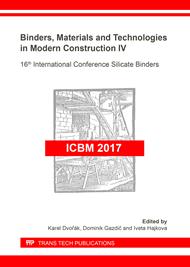[1]
D. Kocáb, T. Komárková, M. Králíková, P. Misák, B. Moravcová, Experimental determination of the influence of fresh concrete composition on its resistance to water and de-icing chemicals by means of two methods, Mater. Technol. 51 (2017) 387-395.
DOI: 10.17222/mit.2015.233
Google Scholar
[2]
M. Šomodíková, B. Teplý, D. Vořechovská, D. Lehký, Modelling of the service life of concrete structures under combined mechanical and environmental actions, Safety and Reliability of Complex Engineered Systems. Switzerland: L. Podofillini et al. 2015, 4219-4224.
DOI: 10.1201/b19094-552
Google Scholar
[3]
B. Kucharczyková, P. Daněk, D. Kocáb, P. Misák, Experimental Analysis on Shrinkage and Swelling in Ordinary Concrete, Advances in Materials Science and Engineering. 2017(2017) 11p.
DOI: 10.1155/2017/3027301
Google Scholar
[4]
E. Holt, Contribution of mixture design to chemical and autogeneous shrinkage of concrete at early ages, Cement and Concrete Research. 35(2005) 464–472.
DOI: 10.1016/j.cemconres.2004.05.009
Google Scholar
[5]
Y. Wei, W. Guo, X. Zheng, Integrated shrinkage, relative humidity, strength development, and cracking potential of internally cured concrete exposed to different drying conditions, Drying Technology. 34 (2015) 741-752.
DOI: 10.1080/07373937.2015.1072549
Google Scholar
[6]
L. Zvolánek, Experimental and numerical analysis of rheological processes during the concrete maturation, Brno University of Technology, Brno, doctoral thesis, 2017 (in Czech).
Google Scholar
[7]
Y. Zhou, J. Gao, Z. Sun, W Qu, A fundamental study on compressive strength, static and dynamic elastic moduli of young concrete, Construction and Building Materials. 98 (2015) 137-145.
DOI: 10.1016/j.conbuildmat.2015.08.110
Google Scholar
[8]
M. Shariq, J. Prasad, H. Abbas, Effect of GGBFS on age dependent static modulus of elasticity of concrete, Construction and Building Materials. 41 (2013) 411-418.
DOI: 10.1016/j.conbuildmat.2012.12.035
Google Scholar
[9]
A. Neville, J. Brooks, Concrete technology, second ed., Prentice Hall, Harlow, England, (2010).
Google Scholar
[10]
J. Newman, B. S. Choo, Advanced concrete technology: Concrete Properties, first ed., Elsevier, Amsterdam, (2003).
Google Scholar
[11]
A. Neville, Properties of concrete, fifth ed., Pearson, New York, (2011).
Google Scholar
[12]
H. Yıldırım, O. Sengul, Modulus of elasticity of substandard and normal concretes, Construction and Building Materials. 25 (2011) 1645-1652.
DOI: 10.1016/j.conbuildmat.2010.10.009
Google Scholar
[13]
N. Kockal, Validity and reliability of estimated modulus of elasticity of cementitious materials, OP Conf. Ser.: Mater. Sci. Eng. 103 (2015) 012024.
DOI: 10.1088/1757-899x/103/1/012024
Google Scholar
[14]
EN 1992-1-1 Eurocode 2: Design of concrete structures - Part 1-1: General rules and rules for buildings, FIRST ED., Brussels, Belgium, Comité Européen de Normalisation (CEN), (2008).
Google Scholar
[15]
R. Silva, J. De Brito, R. Dhir, Establishing a relationship between modulus of elasticity and compressive strength of recycled aggregate concrete, Journal of Cleaner Production. 112 (2016) 2171-2186.
DOI: 10.1016/j.jclepro.2015.10.064
Google Scholar
[16]
ISO 1920-10 Testing of concrete – Part 10: Determination of static modulus of elasticity, Geneva, ISO, (2010).
Google Scholar
[17]
ČSN 73 1372 Non-destructive testing of concrete – Testing of concrete by resonance method, Prague, ÚNMZ, 2012 (in Czech).
Google Scholar
[18]
D. Kocáb, M. Králíková, P. Cikrle, P. Misák, B. Kucharczyková, Experimental analysis of the influence of concrete curing on the development of its elastic modulus over time, Mater. Technol. 51 (2017) 4, 657-665.
DOI: 10.17222/mit.2016.248
Google Scholar
[19]
ČSN 73 1371 Non-destructive testing of concrete – Method of ultrasonic pulse testing of concrete, Prague, ÚNMZ, 2011 (in Czech).
Google Scholar
[20]
I. Rozsypalová, K. Ondřej, B. Kucharczyková, D. Kocáb, R. Halamová, Monitoring of the Setting and Early Hardening with Ultrasonic Waves (to be published 2018).
DOI: 10.4028/www.scientific.net/kem.776.51
Google Scholar
[21]
M. Krüger, Bestimmung elastischer Materialparameter mit Ultraschall, available from http://www.schleibinger.com/cmsimple/?download=k2011_krueger.pdf (in German).
Google Scholar


